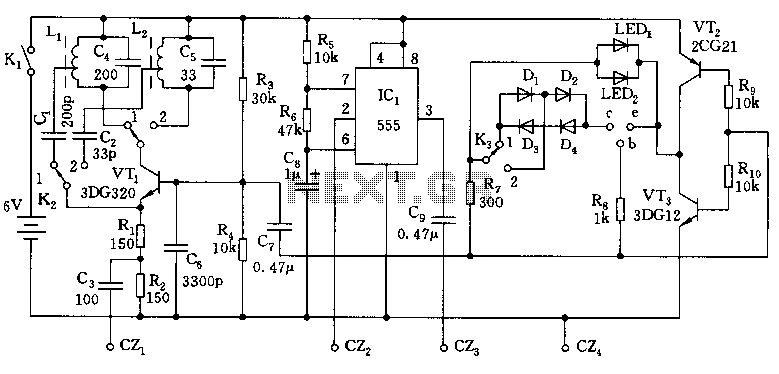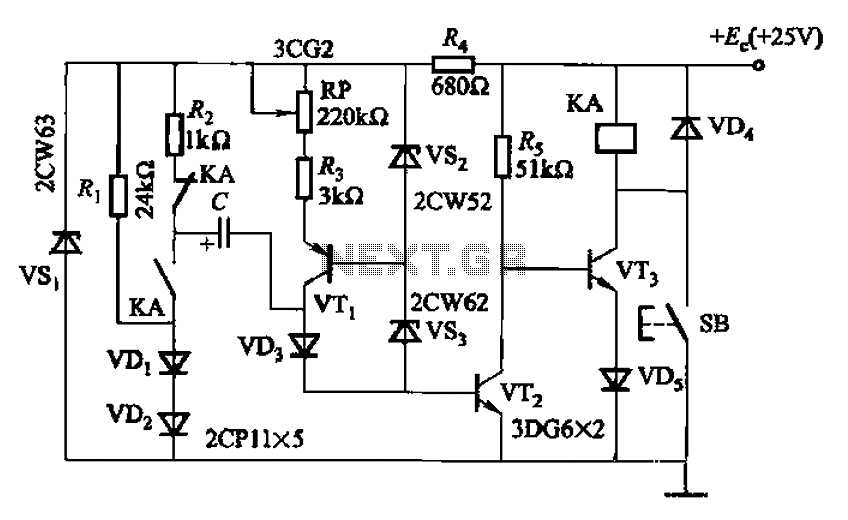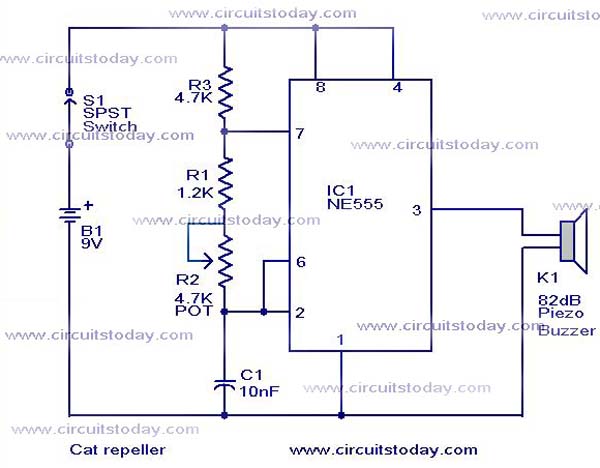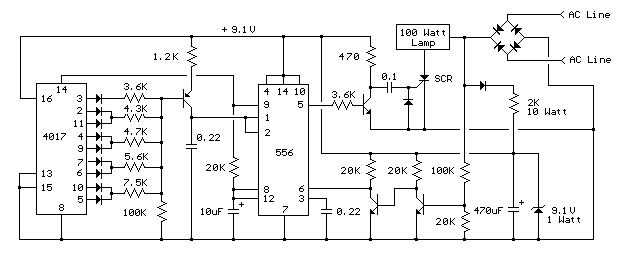
555 multi-purpose repair circuit diagram

The overhaul includes features such as online judge diodes, the ability to test whether transistors are functioning properly, and the capability to assess TTL logic levels or high impedance states. It can output signals at 37 MHz, bar television signals at 74 MHz and 148 MHz, as well as AM signals at 465 kHz, 930 kHz, and 1395 kHz. The circuit utilizes a 555 timer in conjunction with resistors R5 and R6, and capacitor C8 to form an astable multivibrator. The output from this multivibrator is fed into transistors VT1, VT2, and others, generating a test signal at 200 Hz. When the output is high, VT2 is turned off and VT3 is activated; when the output is low, VT2 is activated and VT3 is off. The circuit tests diodes and transistors, with LED1 and LED2 indicating whether the components are functional. The components VT1, L1, L2, C1 through C7, along with the 555 timer, form a frequency oscillator circuit for signal generation. When switch K2 is set to position "1", the output from CZ1 provides AM signals at 465 kHz, 930 kHz, and 1395 kHz, which can be used for repairing radios and tape recorders. When K2 is set to position "2", CZ1 outputs television signals at 37 MHz, 74 MHz, and 148 MHz, suitable for high-frequency maintenance of head and channel sections. CZ4 is used in public places.
The described circuit is a multifunctional electronic testing and signal generation device designed for maintenance and troubleshooting of various electronic components, including transistors, diodes, and TTL logic circuits. The core of the system is built around a 555 timer configured as an astable multivibrator, which generates a square wave output. The frequency of this output can be adjusted by changing the values of resistors R5 and R6, as well as capacitor C8, allowing for versatility in testing different components.
The circuit employs multiple transistors, specifically VT1, VT2, and VT3, to control the flow of signals and to provide testing capabilities. The operation of these transistors is dependent on the output state of the astable multivibrator. When the output is high, VT2 is turned off, allowing current to flow through VT3, indicating a specific testing condition. Conversely, when the output is low, VT2 turns on, effectively disabling VT3. This switching mechanism is crucial for determining the operational status of the components under test.
LED indicators, LED1 and LED2, provide a visual representation of the test results, illuminating when a component is functioning correctly and remaining off when it is faulty. This feature enhances the user experience by allowing for quick and easy verification of component status.
The oscillator circuit formed by components VT1, L1, L2, and capacitors C1 through C7 is responsible for generating the AM signals required for radio and audio equipment testing. The output frequencies of 465 kHz, 930 kHz, and 1395 kHz are particularly useful for servicing older radio and tape recorder models, ensuring compatibility with various devices.
The switch K2 allows users to select between different operating modes. In position "1", the circuit outputs AM signals, while in position "2", it generates television signals at specified frequencies suitable for maintenance tasks. This flexibility makes the circuit an invaluable tool for technicians working with both audio and video equipment.
In summary, this circuit serves as a comprehensive testing and signal generation solution, incorporating a range of functionalities suitable for a variety of electronic maintenance applications. Its design emphasizes ease of use, reliability, and adaptability to different testing scenarios.The overhaul has the following features: online judge diodes, transistors is good or bad; test TTL logic level or a high impedance state; can output 37MHz, bar television signal 74MHz, 148MHz; the output 465kHz, 930kHz, 1395kHz AM signal. As illustrated, 555 and R5, R6, C8 composition astable multivibrator, the output added to the VT1, VT2 and so many were, as a test signal (200Hz). When the output is high, VT2 off, VT3 conduction; low, VT2 conduction. VT3 deadline. Test diodes, transistors, from LED1, LED2 luminescence, the tube can be judged good or bad. VT1, L1, L2, C1 ~ C7 and 555 point-frequency oscillators signal generating circuit. K2 "1" at, CZ1 output of the AM signal 465,930,1395kHz to repair radios, tape recorders, etc; K2 is set to "2", CZ1 TV output 37,74,148MHz bar signal for high frequency maintenance head and channel section.
CZ4 public places.
The described circuit is a multifunctional electronic testing and signal generation device designed for maintenance and troubleshooting of various electronic components, including transistors, diodes, and TTL logic circuits. The core of the system is built around a 555 timer configured as an astable multivibrator, which generates a square wave output. The frequency of this output can be adjusted by changing the values of resistors R5 and R6, as well as capacitor C8, allowing for versatility in testing different components.
The circuit employs multiple transistors, specifically VT1, VT2, and VT3, to control the flow of signals and to provide testing capabilities. The operation of these transistors is dependent on the output state of the astable multivibrator. When the output is high, VT2 is turned off, allowing current to flow through VT3, indicating a specific testing condition. Conversely, when the output is low, VT2 turns on, effectively disabling VT3. This switching mechanism is crucial for determining the operational status of the components under test.
LED indicators, LED1 and LED2, provide a visual representation of the test results, illuminating when a component is functioning correctly and remaining off when it is faulty. This feature enhances the user experience by allowing for quick and easy verification of component status.
The oscillator circuit formed by components VT1, L1, L2, and capacitors C1 through C7 is responsible for generating the AM signals required for radio and audio equipment testing. The output frequencies of 465 kHz, 930 kHz, and 1395 kHz are particularly useful for servicing older radio and tape recorder models, ensuring compatibility with various devices.
The switch K2 allows users to select between different operating modes. In position "1", the circuit outputs AM signals, while in position "2", it generates television signals at specified frequencies suitable for maintenance tasks. This flexibility makes the circuit an invaluable tool for technicians working with both audio and video equipment.
In summary, this circuit serves as a comprehensive testing and signal generation solution, incorporating a range of functionalities suitable for a variety of electronic maintenance applications. Its design emphasizes ease of use, reliability, and adaptability to different testing scenarios.The overhaul has the following features: online judge diodes, transistors is good or bad; test TTL logic level or a high impedance state; can output 37MHz, bar television signal 74MHz, 148MHz; the output 465kHz, 930kHz, 1395kHz AM signal. As illustrated, 555 and R5, R6, C8 composition astable multivibrator, the output added to the VT1, VT2 and so many were, as a test signal (200Hz). When the output is high, VT2 off, VT3 conduction; low, VT2 conduction. VT3 deadline. Test diodes, transistors, from LED1, LED2 luminescence, the tube can be judged good or bad. VT1, L1, L2, C1 ~ C7 and 555 point-frequency oscillators signal generating circuit. K2 "1" at, CZ1 output of the AM signal 465,930,1395kHz to repair radios, tape recorders, etc; K2 is set to "2", CZ1 TV output 37,74,148MHz bar signal for high frequency maintenance head and channel section.
CZ4 public places.





